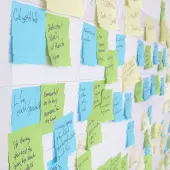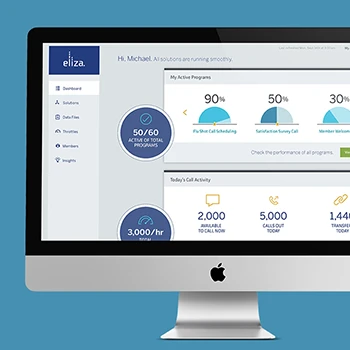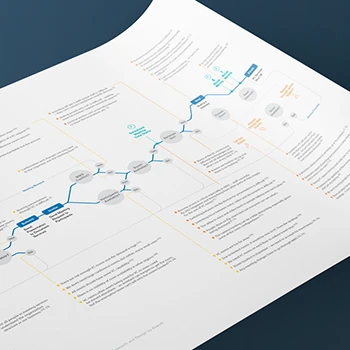What exactly is service journey mapping and why do we need it for our business?
Service journey mapping is a research-driven visualization that captures every interaction and impression people have across all touchpoints of your service experience. Unlike product-focused mapping, service journey mapping reveals how customers move between different channels - online, in-person, phone, email - and how these experiences connect. Within our Experience Thinking framework, journey mapping ensures brand, content, product, and service experiences flow seamlessly together rather than operating in silos.
Tip: Start with your most critical customer lifecycle stage rather than trying to map the entire journey at once.
How does service journey mapping differ from customer journey mapping or user journey mapping?
Service journey mapping captures the complete end-to-end experience across multiple service touchpoints and channels, while customer journey mapping typically focuses on purchasing decisions and user journey mapping emphasizes task completion within specific products. Service mapping reveals the connections between brand interactions, content consumption, product usage, and service delivery. It includes both customer-facing experiences and internal service delivery processes that enable those experiences.
Tip: Use service journey mapping when your business involves multiple touchpoints and channels rather than single-product interactions.
What business problems does service journey mapping solve most effectively?
Service journey mapping effectively addresses experience inconsistencies across channels, service delivery gaps, customer retention challenges, and operational inefficiencies. It reveals where customers experience friction between touchpoints, identifies moments that matter most for satisfaction, and uncovers opportunities for service innovation. The mapping process also helps organizations understand resource allocation needs and prioritize improvements based on actual customer experience impact.
Tip: Focus initial mapping efforts on your highest-value customer segments or most problematic service areas for maximum business impact.
What components should be included in effective service journey mapping?
Effective service journey mapping includes experience lifecycle phases, customer goals and motivations, activities and tasks, touchpoints and channels, emotions and satisfaction levels, pain points and opportunities, supporting artifacts and tools, and people involved in service delivery. Within Experience Thinking methodology, maps also capture how brand, content, product, and service experiences interconnect throughout the journey. Context and frequency information reveal environmental factors that influence experiences.
Tip: Include both emotional and functional aspects of the journey since service satisfaction depends on both what happens and how it feels.
How detailed should service journey maps be without becoming overwhelming to use?
Service journey maps should balance comprehensive insight with practical usability through structured detail levels. High-level maps capture major phases and key touchpoints for strategic planning. Detailed maps include specific interactions, emotions, and operational elements for tactical improvements. Visual hierarchy, clear navigation, and modular design help manage complexity while ensuring maps remain accessible for different stakeholder needs and decision-making contexts.
Tip: Create multiple map versions for different audiences - executive summaries for leadership and detailed tactical maps for operational teams.
What role does foresight design play in service journey mapping?
Foresight design enhances service journey mapping by exploring how customer needs, behaviors, and service expectations might evolve over time. Rather than just mapping current journeys, foresight design helps anticipate future journey variations, emerging touchpoints, and changing interaction patterns. This approach creates more resilient service strategies that remain relevant as technology, society, and business models change, enabling proactive rather than reactive service evolution.
Tip: Include scenario planning exercises to explore how your service journeys might need to adapt to different future contexts and technologies.
How do service journey maps connect to business strategy and organizational goals?
Service journey maps connect to business strategy by revealing how customer experiences drive key performance indicators like retention, satisfaction, operational efficiency, and revenue growth. Maps identify which journey moments have greatest business impact and where investments in experience improvements will generate highest returns. Within Experience Thinking, journey insights inform strategic decisions across brand positioning, content strategy, product development, and service delivery priorities.
Tip: Map business metrics to specific journey stages to understand which customer experience improvements will drive the most valuable business outcomes.
What research methods work best for creating accurate service journey maps?
Service journey mapping research combines ethnographic observation, contextual interviews, diary studies, touchpoint analysis, and stakeholder workshops. Behavioral data from service delivery systems provides quantitative journey patterns while qualitative methods reveal emotional insights and contextual factors. Mixed methods ensure maps reflect both actual customer behaviors and underlying motivations. Longitudinal research tracks journey evolution over time and across different contexts.
Tip: Observe actual service interactions rather than just asking people to describe their journeys, since behavior often differs from self-reported experiences.
How do we research service journeys across multiple channels and touchpoints effectively?
Multi-channel service journey research requires systematic tracking of customer interactions across all touchpoints including digital platforms, physical locations, phone support, email, and third-party channels. Cross-channel journey tracking reveals how preferences and behaviors shift between touchpoints. Research methods include channel-specific observation, cross-touchpoint interviews, and journey reconstruction exercises that capture handoff experiences and continuity expectations.
Tip: Use journey tracking tools or diaries to capture cross-channel experiences as they happen rather than relying on retrospective recall.
What sample sizes and participant selection criteria should we use for journey mapping research?
Service journey mapping research typically requires 15-30 participants per major customer segment for qualitative insights, with larger samples for quantitative validation. Participant selection should represent journey diversity rather than just demographic variety. Include customers at different lifecycle stages, using different channels, with varying experience satisfaction levels. Geographic and temporal representation matters for services operating across diverse contexts.
Tip: Prioritize journey behavior diversity over demographic quotas when recruiting participants to ensure maps capture genuine usage variations.
How do we capture emotional and contextual aspects of service journeys effectively?
Emotional and contextual journey research requires immersive methods like service shadowing, experience diaries, photo journals, and emotional journey tracking. Critical incident analysis reveals peak emotional moments. Environmental analysis captures how physical, social, and temporal contexts influence journey experiences. These methods within Experience Thinking ensure maps reflect the complete service experience including functional, emotional, and contextual dimensions.
Tip: Use real-time emotional tracking tools or moment-based prompts to capture feelings as they occur rather than relying on post-experience reflection.
What role should existing operational data play in service journey mapping research?
Existing operational data provides essential behavioral baselines showing actual journey patterns, channel usage, completion rates, and service outcomes. Analytics reveal journey volume, timing, and success metrics while customer service data shows common pain points and resolution patterns. However, operational data cannot capture motivations, emotions, and contextual factors. Integration of quantitative data with qualitative insights creates more accurate and actionable journey maps.
Tip: Use operational data to identify journey patterns and issues, then conduct qualitative research to understand the why behind the behaviors.
How do we validate service journey maps to ensure they accurately represent real customer experiences?
Service journey map validation involves testing maps against real customer scenarios, comparing journey predictions with actual customer behaviors, and gathering feedback from both customers and service delivery staff. Walkthrough sessions with customers, journey simulation exercises, and pilot testing of journey improvements reveal map accuracy. Regular validation ensures maps remain current as customer needs and service contexts evolve.
Tip: Create journey scenarios based on your maps and test them with both customers and front-line service staff to confirm accuracy.
What timeline should we expect for thorough service journey mapping research and development?
Service journey mapping research typically requires 10-16 weeks including research design, participant recruitment, data collection across multiple touchpoints, analysis, map development, and validation. Timeline depends on journey complexity, number of channels studied, stakeholder availability, and validation requirements. Rush timelines often result in superficial maps that miss critical emotional and contextual insights needed for effective service improvement.
Tip: Plan for longer timelines if your service operates across multiple time zones, seasonal patterns, or requires observation of rare but critical journey events.
How do we align service journey mapping with current business objectives and priorities?
Service journey mapping alignment begins with understanding business goals, competitive challenges, growth strategies, and operational constraints before designing research approaches. Maps should directly connect to key performance indicators, customer satisfaction targets, and operational efficiency goals. Experience Thinking methodology helps align journey insights across brand positioning, content strategy, product development, and service delivery objectives to ensure research creates actionable business value.
Tip: Start mapping projects by identifying specific business decisions that journey insights need to inform.
What stakeholders should be involved in service journey mapping planning and development?
Service journey mapping requires input from customer service, sales, marketing, operations, IT, and leadership stakeholders who have different perspectives on customer needs and business priorities. Front-line staff provide operational insights while leadership ensures strategic alignment. Including diverse stakeholders ensures maps address various organizational requirements and gain broader internal support for resulting improvements.
Tip: Create a stakeholder map showing how each group will use journey insights to ensure research captures their specific decision-making needs.
How do service journey maps help prioritize improvement initiatives and resource allocation?
Service journey maps help prioritize improvements by revealing which journey moments have greatest impact on customer satisfaction, business outcomes, and operational efficiency. Pain point analysis, opportunity identification, and business impact assessment guide resource allocation decisions. Maps show where small improvements create large customer value and where major investments are needed for competitive advantage.
Tip: Create impact-effort matrices for journey improvement opportunities to identify quick wins alongside strategic initiatives.
What organizational changes might be needed to effectively use journey mapping insights?
Effective journey map implementation often requires changes in decision-making processes, performance metrics, cross-functional collaboration approaches, and customer-centric culture development. Organizations may need new roles focused on customer experience, updated service standards reflecting journey insights, and systems enabling journey-based service delivery. Change management supports successful journey map adoption across all service touchpoints.
Tip: Plan organizational change management alongside journey mapping to ensure insights translate into operational improvements.
How do we build business cases that justify investment in service journey mapping research?
Business cases for service journey mapping should quantify potential improvements in customer satisfaction, retention rates, operational efficiency, and revenue growth. Calculate costs of current journey inefficiencies, customer churn at specific stages, and missed opportunities that mapping could address. Include competitive analysis showing how journey-based service improvements create market advantages. ROI projections should reflect both quantitative improvements and strategic positioning benefits.
Tip: Include competitive analysis showing how customer-centric journey design creates market advantages that justify research investment.
How do service journey maps support cross-functional collaboration and break down organizational silos?
Service journey maps support collaboration by providing shared understanding of customer experiences that transcend departmental boundaries. Maps reveal how different functions impact the same customer journey stages, encouraging coordination rather than isolated optimization. Visual journey representations facilitate conversations between departments and create common language for customer-focused decision making. Shared ownership of journey outcomes builds collaborative culture.
Tip: Use journey maps in cross-functional planning sessions to identify collaboration opportunities and shared success metrics.
What communication strategies help stakeholders understand and adopt journey mapping insights?
Effective communication combines visual storytelling, role-specific insights, and practical application examples that help stakeholders internalize customer perspectives. Interactive presentations, persona-based scenarios, and real customer quotes make abstract journey insights tangible. Regular reinforcement through team meetings, performance feedback, and success stories maintains journey awareness across the organization. Customized insights for different stakeholder groups ensure relevance.
Tip: Create journey-based training scenarios that stakeholders practice regularly to build intuitive understanding of customer needs.
How do service journey maps translate into actual service design and delivery improvements?
Service journey maps translate into improvements through specific design applications like service blueprints, process redesign, touchpoint optimization, and staff training programs. Within Experience Thinking methodology, maps inform how brand, content, product, and service experiences connect to create seamless customer journeys. Implementation requires systematic integration into existing operations, new service standards, and performance measurement systems aligned with journey insights.
Tip: Create journey-specific improvement roadmaps with clear priorities, timelines, and success metrics for systematic implementation.
What role do service journey maps play in experience design and innovation?
Service journey maps drive experience design by revealing unmet needs, emotional peaks and valleys, and opportunities for differentiation throughout customer journeys. Maps identify moments that matter most for customer satisfaction and loyalty. Innovation opportunities emerge from journey gaps, pain points, and changing customer expectations. Foresight design principles help anticipate future journey requirements and design adaptive service capabilities.
Tip: Focus innovation efforts on journey moments with highest emotional impact rather than just functional improvements.
How do we prioritize service journey improvements based on customer impact and business value?
Service journey improvement prioritization balances customer pain point severity, business impact potential, implementation effort, and strategic alignment. High-impact, low-effort improvements provide quick wins while strategic initiatives address fundamental journey redesign. Customer value assessment considers both functional improvements and emotional experience enhancement. Business value includes revenue impact, cost reduction, competitive advantage, and operational efficiency gains.
Tip: Create prioritization frameworks that balance customer pain severity with business opportunity size to guide improvement investments.
What service design patterns and best practices emerge from journey mapping insights?
Journey mapping reveals service design patterns like effective onboarding sequences, seamless channel transitions, proactive communication timing, and recovery protocols for service failures. Best practices include consistent experience quality across touchpoints, clear expectations setting, progress indicators, and personalization opportunities. Experience Thinking patterns ensure brand, content, product, and service elements work together rather than competing for customer attention.
Tip: Document successful journey patterns from your maps as reusable design templates for future service development.
How do service journey maps inform channel strategy and omnichannel experience design?
Service journey maps inform channel strategy by revealing where customers prefer different touchpoints, how they move between channels, and what continuity expectations exist. Maps guide channel investment decisions, integration requirements, and specialized channel capabilities. Within Experience Thinking, maps ensure consistent experience quality across all channels while respecting channel-specific strengths and customer preferences for seamless omnichannel experiences.
Tip: Map channel handoffs and transitions to identify integration points where seamless continuity is most critical for customer satisfaction.
What operational changes are typically needed to support journey-based service delivery?
Journey-based service delivery often requires changes in staff training, performance metrics, technology systems, and process workflows. Organizations may need customer journey visibility tools, cross-functional collaboration protocols, and service standards reflecting journey insights. Operational changes include journey-based quality assurance, customer feedback loops, and continuous improvement processes that maintain journey alignment over time.
Tip: Implement journey visibility dashboards that help operational staff understand customer context and make appropriate service decisions.
How do we measure success and track improvement progress from journey mapping initiatives?
Journey mapping success measurement includes customer satisfaction improvements at specific journey stages, operational efficiency gains, completion rate increases, and reduced customer effort scores. Journey-specific metrics reveal whether improvements address identified pain points and create intended value. Business impact measures include retention improvements, revenue per customer increases, and service cost reductions attributed to journey enhancements.
Tip: Establish baseline measurements for key journey stages before implementing improvements to accurately track progress and ROI.
How does artificial intelligence enhance service journey mapping research and application?
AI enhances service journey mapping through automated pattern recognition in customer behavioral data, natural language processing of feedback across touchpoints, and predictive modeling of journey outcomes. Machine learning algorithms identify journey anomalies, suggest improvement opportunities, and personalize journey experiences based on customer patterns. However, AI augments rather than replaces human insight in understanding complex emotional and contextual factors that drive journey satisfaction.
Tip: Use AI for journey data analysis and pattern identification while maintaining human oversight for emotional interpretation and strategic application.
What role do analytics and behavioral data play in journey mapping development and validation?
Analytics and behavioral data provide quantitative foundations for journey mapping by revealing actual customer paths, completion rates, abandonment points, and channel preferences. Data analysis identifies journey patterns and validates qualitative research findings. Ongoing analytics track journey performance and reveal behavior changes requiring map updates. Integration of quantitative patterns with qualitative insights creates more robust and actionable service journey maps.
Tip: Combine analytics insights with observational research to understand both what customers do and why they behave that way in journeys.
How do digital platforms and customer relationship management systems support journey-based experiences?
Digital platforms support journey-based experiences through customer journey tracking, personalized content delivery, interaction history maintenance, and automated service routing based on journey stage. CRM systems store journey progress, preferences, and interaction context enabling consistent service delivery across touchpoints. Integration across platforms ensures journey continuity and appropriate treatment regardless of how customers access services.
Tip: Ensure platform integration enables seamless journey recognition and appropriate service delivery across all digital and human touchpoints.
What automation opportunities exist for journey-based service delivery without losing human connection?
Automation opportunities include journey stage identification, personalized content delivery, routine transaction processing, and proactive communication based on journey patterns while preserving human interaction for complex issues and relationship building. Within Experience Thinking, automation should enhance journey quality and efficiency without compromising human elements that create emotional connection and trust throughout customer journeys.
Tip: Design automation to enhance journey flow efficiently while ensuring easy escalation to human staff when customer needs require personal attention.
How do emerging technologies like voice interfaces and IoT integrate with service journey strategies?
Emerging technologies integrate with journey strategies by providing new touchpoints, interaction modes, and contextual information that enhance journey experiences. Voice interfaces enable natural journey navigation while IoT devices provide real-time context about customer situations and needs. Technology implementation should enhance rather than complicate journey flows while maintaining consistency with established journey expectations and preferences.
Tip: Design emerging technology implementations to enhance existing journey patterns rather than requiring customers to learn entirely new interaction models.
What data privacy and security considerations are important when tracking customer journeys?
Journey tracking must comply with privacy regulations, obtain appropriate consent for data collection, and implement security measures protecting customer information. Journey maps should aggregate individual data into patterns rather than storing personally identifiable journey details. Transparency about data usage, anonymization practices, and customer control over information builds trust while enabling effective journey optimization and personalization.
Tip: Work with legal and compliance departments early in journey mapping planning to ensure all privacy requirements are properly addressed.
How do we balance technological efficiency with personalized journey experiences?
Balancing efficiency with personalization requires technology platforms that enable mass customization rather than mass standardization. Systems should provide consistent core journey functionality while allowing personalized variations in content, timing, and interaction style. Effective balance maintains operational efficiency while delivering relevant, personalized experiences that meet diverse customer needs throughout service journeys.
Tip: Implement flexible technology architectures that enable journey personalization without creating separate systems for each customer segment.
How do service journey maps drive organizational culture change toward customer-centricity?
Service journey maps drive culture change by making customer experiences visible and tangible across the organization. Maps create shared understanding of customer needs that transcends departmental perspectives. Visual journey representations facilitate customer-focused conversations and decision-making. Regular journey review sessions, customer story sharing, and journey-based performance metrics reinforce customer-centric thinking and behavior throughout the organization.
Tip: Display journey maps prominently in offices and meeting rooms to keep customer experiences visible during all business discussions.
What training and capability building are needed to effectively use journey mapping insights?
Effective journey mapping capability building includes customer empathy training, journey analysis skills, cross-functional collaboration techniques, and service design thinking. Training programs should cover journey interpretation, improvement prioritization, and implementation planning. Capability development also includes establishing communities of practice, mentorship programs, and knowledge sharing systems that build organizational journey mapping expertise over time.
Tip: Create hands-on training programs where staff practice applying journey insights to real business decisions rather than just learning theoretical concepts.
How do service journey maps inform organizational structure and role design?
Service journey maps inform organizational structure by revealing coordination requirements, skill needs, and accountability patterns needed for effective journey delivery. Maps may indicate needs for customer experience roles, cross-functional collaboration mechanisms, and journey-focused performance management. Organizational design should support journey outcomes rather than functional optimization that creates customer experience gaps.
Tip: Analyze journey touchpoint ownership and identify organizational gaps where no one has clear responsibility for customer experience quality.
What role do service journey maps play in change management and transformation initiatives?
Service journey maps support change management by providing compelling evidence for transformation needs, visual communication of future state visions, and specific guidance for implementation priorities. Maps help stakeholders understand transformation impact on customer experiences and build support for necessary changes. Journey insights guide transformation planning to ensure changes improve rather than disrupt customer experiences.
Tip: Use current state journey maps to build urgency for change and future state maps to inspire transformation vision and commitment.
How do global and multicultural considerations affect service journey mapping and implementation?
Global service journey mapping must account for cultural differences in service expectations, communication preferences, relationship styles, and contextual factors affecting customer behavior. Cultural adaptation goes beyond language translation to include different concepts of time, hierarchy, and service relationship expectations. Effective global journey maps balance universal human needs with culture-specific service requirements and implementation approaches.
Tip: Collaborate with local market experts during journey mapping to capture cultural nuances that external researchers might misinterpret.
What emerging trends are shaping the future of service journey mapping and application?
Emerging trends include real-time journey analytics, AI-enhanced personalization, predictive journey modeling, and integration with IoT data sources. Sustainability concerns, remote service delivery, and changing work patterns also influence journey mapping. Foresight design approaches help anticipate how these trends will affect customer expectations and service delivery requirements, enabling proactive journey evolution rather than reactive adaptation.
Tip: Monitor emerging technology capabilities and social trends that might change how customers want to experience journeys in the future.
How do service journey maps contribute to innovation strategy and competitive advantage?
Service journey maps contribute to innovation by revealing unmet needs, emerging requirements, and differentiation opportunities that traditional market research might miss. Within Experience Thinking, maps identify innovation possibilities across brand, content, product, and service dimensions. Journey insights guide innovation investment priorities and validate concepts before development. Competitive advantage emerges from superior journey understanding and execution rather than just better individual touchpoints.
Tip: Use journey maps to identify white space opportunities where competitors are not meeting customer needs or expectations effectively.
How do service journey maps evolve as markets change and customer expectations shift?
Service journey maps evolve through continuous monitoring of customer behavior changes, market trend analysis, and regular research updates capturing shifting expectations and needs. Foresight design principles help anticipate journey evolution rather than just react to changes. Evolution patterns often reflect broader societal shifts, technology adoption, competitive influences, and generational changes affecting how customers interact with services across all touchpoints.
Tip: Establish journey evolution tracking systems that identify early signals of behavior changes before they become widespread customer expectations.
What advanced applications of service journey mapping can create breakthrough experiences?
Advanced applications include predictive journey personalization, real-time journey optimization, proactive issue resolution, and dynamic service adaptation based on customer context and patterns. Integration across service ecosystems enables coordinated experiences and anticipatory service delivery. Experience Thinking methodology ensures advanced applications enhance rather than complicate fundamental human aspects of service relationships while creating competitive advantage.
Tip: Focus advanced applications on enhancing human connection and problem-solving effectiveness rather than just technological sophistication.
How do service journey maps support strategic planning and future service development?
Service journey maps support strategic planning by revealing market opportunities, customer value creation potential, and innovation requirements for future service success. Maps help evaluate strategic initiatives based on customer impact rather than internal capabilities alone. Journey insights guide resource allocation, capability development, and partnership decisions that position organizations for evolving customer needs and competitive landscapes.
Tip: Use journey trend analysis to identify strategic capabilities your organization needs to develop for future customer expectations.
What role do service journey maps play in service platform and ecosystem design?
Service journey maps inform platform and ecosystem design by revealing integration requirements, partnership opportunities, and service architecture needs for comprehensive customer value delivery. Maps show where internal capabilities should be supplemented with external partnerships or platform solutions. Ecosystem design ensures journey continuity across multiple service providers while maintaining consistent experience quality and customer relationship ownership.
Tip: Map ecosystem partnerships based on customer journey value rather than just operational convenience to ensure integrated experiences.
How do service journey maps contribute to sustainability and social responsibility initiatives?
Service journey maps contribute to sustainability by revealing environmental impacts of different journey paths, identifying opportunities for resource efficiency, and understanding customer values regarding social responsibility. Maps help design services that align with customer sustainability expectations while achieving business objectives. Responsible journey design considers broader social impacts and long-term value creation beyond immediate customer satisfaction.
Tip: Include sustainability values and environmental impact in journey research to understand how these factors influence customer decisions and loyalty.
What competitive intelligence can be gained from service journey mapping analysis?
Service journey mapping reveals competitive advantages and vulnerabilities by comparing journey experiences, identifying differentiation opportunities, and understanding market positioning through customer experience lens. Competitive journey analysis shows where competitors excel or fail in customer experience delivery. Market intelligence includes understanding industry journey standards, emerging experience expectations, and innovation opportunities that create competitive advantage.
Tip: Conduct competitive journey analysis to identify experience gaps where your organization can create meaningful differentiation.
How do service journey maps prepare organizations for future customer behavior and technology changes?
Service journey maps prepare organizations for future changes by establishing adaptive service capabilities, identifying technology integration opportunities, and building customer insight infrastructure that can evolve with changing needs. Foresight design approaches using journey mapping help anticipate customer behavior evolution and design flexible service architectures. Preparedness includes scenario planning, capability building, and innovation processes that enable rapid response to customer expectation changes.
Tip: Build service flexibility and adaptation capability into your organization rather than just optimizing for current customer journey patterns.












